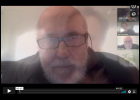Fred Forest
Fred Forest was born in Mascara, Algeria, in 1933. From 1967 on he has been one of the pioneers of video art in France. As a multimedia and net artist he uses, in turn, newspapers, telephones, faxes, video, radio, television, computer, telematic nets, and of course the internet. He is professor at the École Nationale d’Art de Cergy (France), as well as in charge of the Chaire des Sciences de l’Information et de la Communication at the university of Nice Sophia-Antipolis. He is also director of the Musée d’Art Moderne et d’Art Contemporain of Nice. Fred Forest published a series of essays on art and comunication: Pour un art actuel/l’art à l’heure d’Internet, Paris, 1998; Fonctionnements et dysfonctionnements de l’art contemporain : un procès pour l’exemple, Paris, 2000; Repenser l'art et son enseignement and De l'art vidéo au Net Art, Paris, 2004 as well as L'Oeuvre-système invisible, Paris 2005. He took part in numerous exhibitions, among them the Biennale of Venice in 1976, the Documenta 6 Kassel in 1977 and the Biennale 2000 at the MAC of São Paulo in 1975. A series of individual exhibitions have been organized so far: in the Centre Georges Pompidou (1982), at the Slought Foundation of Philadelphia (2007), as well as in Sarajevo, Nice, Naples and Nîmes. Websites: http://www.fredforest.org and http://www.webnetmuseum.org/
Articles of Fred Forest
Interview
In this interview, Fred Forest, Jean-Louis Poitevin and Martial Verdier, discuss the relationship between Fred Forest and Vilém Flusser, their collaboration over the years and the influence they had on each other’s work and thinking. Verdier was at one time Forest’s assistant; he is now Secrétaire Général of TK21 and has recorded and edited the discussion. The interview begins with their first meeting between Forest and Flusser and the person of Flusser himself. It then moves on to a major field of collaboration: gestures (ca. 4.38) and the role of dialogue and intersubjectivity (ca. 5.55). They also discuss the notion of apparatus (ca. 9.00), video (ca. 17.25) and the group “Art Scociologique” (ca. 20.25 and again ca. 37.40). Forest talks about the dissolution of the group and about one of his members Hervé Fischer (ca. 38.30) (see the interview with Fischer in this issue). Verdier questions Forest about Flusser’s impact on his work and the way he himself influenced Flusser’s thinking (ca. 29.30). The very last question concerns the future of art. The situation today, Forest says, is tragic, but there is also hope for “a return to more honest, profound and valuable” things.
Password: Flusser
Interview avec Fred Forest / Entrevista com Fred Forest
This conversation about Vilém Flusser, between new media art critic Annick Bureaud and media artist Fred Forest, took place in Paris on December 22, 2008. Forest is a pioneer of video, media and network art whose actions and interventions establish pauses and disruptions in the usual flow of communication. His works are frequently critical, often humorous and on occasion insolent. Forest also writes and theorizes his own artistic creations besides maintaining a constant dialogue with philosophers and theorists. Flusser was one of those with whom intellectual exchange was always densely rich, productive and collaborative. In this interview, Forest speaks about some of his video projects developed with Flusser, as well as his news media and public interventions in the 1973 São Paulo Bienal, for which Flusser served as curator. Bureaud and Forest’s conversation bring to life the energy and more human, intersubjective exchanges that characterized the Forest-Flusser friendship, and which are seminal to both artistic creation and intellectual thought. Bureaud insightfully points out that unfortunately such vivid encounters are rarely found in scholarly research and in the history of art. In the hands of Forest and Flusser though, often overlooked gestures, shared for instance in a seemingly banal conversation on a summer afternoon or on a subway ride in Paris, become fully meaningful.

